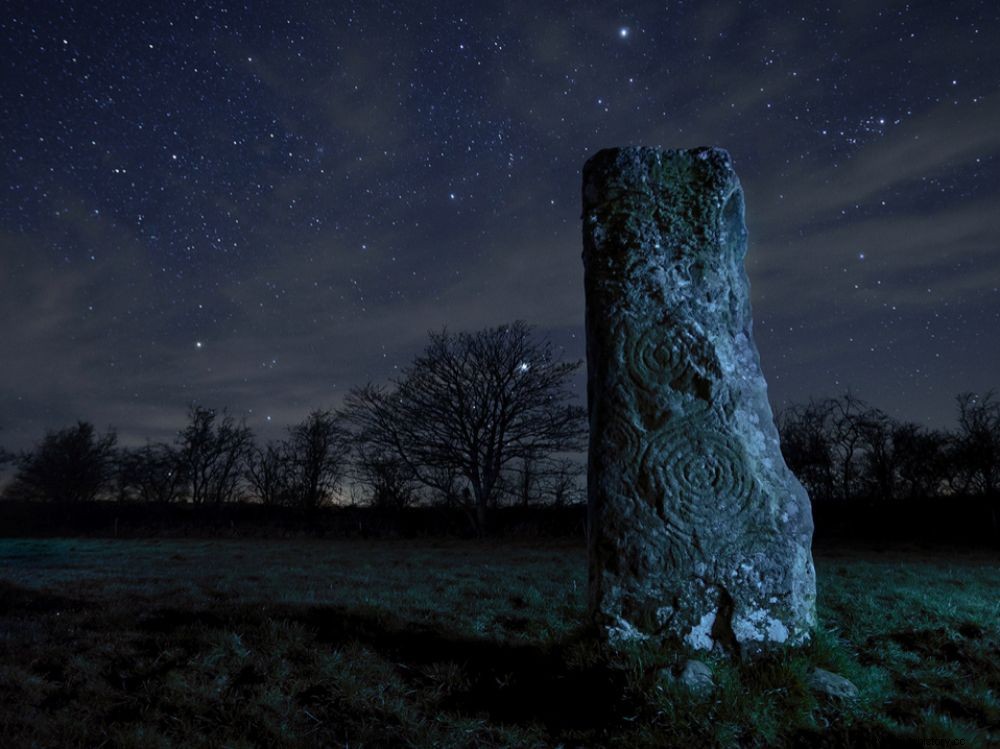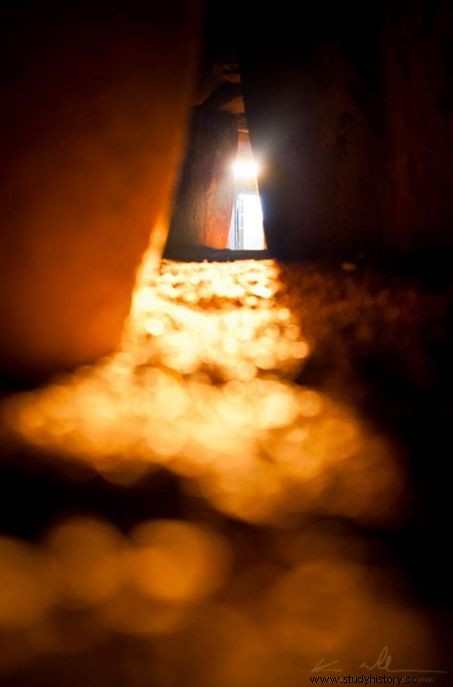More than 3,000 years BC in Ireland, even before the construction of the Great Pyramids, genetic analyzes reveal the preeminence of an inbred elite.

Star trails above Irish passage tombs.
Legend has it that every day, the King-Builder restarts the solar cycle by sleeping with his sister. Is there any truth in this popular Irish story from the 11th century? Male remains found in a famous and imposing tomb on the island indeed reveal the existence of an incestuous dynasty more than 5,000 years ago! These results published in Nature are based on the work of archaeologists and geneticists, under the direction of those at Trinity College in Dublin (Ireland).
A man of consanguineous relationship, in a tomb older than the pyramids
At the heart of the tomb in Newgrange Passage lie the remains of a grown man. Built between 3,200 and 3,000 BC, several centuries before the great pyramids of Egypt, Newgrange is a megalithic mound incorporating more than 200,000 tons of earth and stones, one of the most spectacular of its kind known in Europe. This enormous circular building is one of the three main tombs built on the site of Brú na Bóinne, north of Dublin and registered as a UNESCO heritage site.
Inside the tomb is a single narrow passage leading to a burial chamber. It is only illuminated by the rays of the rising sun for a few minutes a year, during the winter solstice. In the most elaborately decorated hollow of the terminal chamber of this corridor, the human remains bear witness to a singular genetic heritage. "I had never seen anything like it “, underlines in a press release Dr. Lara Cassidy, first author of the article. “We all inherit two copies of the genome, one from our mother and the other from our father. But the copies of this individual were extremely similar, a sign of close inbreeding ". The rate of consanguinity between the man and his parents reaches the record of 25%, which is the equivalent of a brother and a sister, or a mother and a son. It is the same score reached by Charles II, last of the Habsburg dynasty. Clearly, this means that the Newgrange man's parents were either brother and sister or parent and child.
Legend has it that every day, the King-Builder restarts the solar cycle by sleeping with his sister. Is there any truth in this popular Irish story from the 11th century? Male remains found in a famous and imposing tomb on the island indeed reveal the existence of an incestuous dynasty more than 5,000 years ago! These results published in Nature are based on the work of archaeologists and geneticists, under the direction of those at Trinity College in Dublin (Ireland).
A man of consanguineous relationship, in a tomb older than the pyramids
At the heart of the tomb in Newgrange Passage lie the remains of a grown man. Built between 3,200 and 3,000 BC, several centuries before the great pyramids of Egypt, Newgrange is a megalithic mound incorporating more than 200,000 tons of earth and stones, one of the most spectacular of its kind known in Europe. This enormous circular building is one of the three main tombs built on the site of Brú na Bóinne, north of Dublin and registered as a UNESCO heritage site.

Newgrange's bedroom. Credits:Ken Williams, shadowsandstone.com
Inside the tomb is a single narrow passage leading to a burial chamber. It is only illuminated by the rays of the rising sun for a few minutes a year, during the winter solstice. In the most elaborately decorated hollow of the terminal chamber of this corridor, the human remains bear witness to a singular genetic heritage. "I had never seen anything like it “, underlines in a press release Dr. Lara Cassidy, first author of the article. “We all inherit two copies of the genome, one from our mother and the other from our father. But the copies of this individual were extremely similar, a sign of close inbreeding ". The rate of consanguinity between the man and his parents reaches the record of 25%, which is the equivalent of a brother and a sister, or a mother and a son. It is the same score reached by Charles II, last of the Habsburg dynasty. Clearly, this means that the Newgrange man's parents were either brother and sister or parent and child.
Read alsoFacial deformities of the Habsburg dynasty explained by science
An elite of god-kings present over half a millennium
If the genetic analyzes cannot decide, the authors lean on the other hand for the hypothesis of the brother and sister, "only known definitive acceptance of such a coupling (…) within the framework of a rarely observed phenomenon called incest 'royal' or 'dynastic'" . This first-degree incestuous union from which man is born is indeed an almost universal taboo, for both biological and cultural reasons. This discovery could mean that the elite associated with this magnificent monument practiced incest as a means of maintaining a dynastic lineage. "Such a strategy was also practiced much later by the ruling elites of ancient Egypt, the Inca Empire and ancient Hawaii “, specifies Alison Sheridan, Scottish archaeologist, in a commentary published in Nature . "This behavior coincides with the deification of political leaders and is usually confined to ruling families, whose perceived divinity exempts them from social convention ", confirm the authors. The prestige associated with the man's grave "makes a socially sanctioned union very likely and speaks of a hierarchy so extreme that the only elite worthy partners were family members. “, says in a press release Dan Bradley, professor of genetics and co-author of this work.
The social landscape of the time takes shape when researchers identify a whole web of distant family relationships between the man and others found at "passage tomb" sites across the country, including the megacemeteries of Carrowmore and Carrowkeel in County Sligo. The man's own relatives are notably found in two other large passage tomb complexes 150 km west of Newgrange. "It appears we have a powerful extended kin group here, who have had access to elite burial sites in many parts of the island for at least half a millennium ", decrypts Dr. Cassidy.
A dynasty that emerged after a wave of immigration from England.. And France
This elite would have arisen in a context of rapid maritime colonization from England, which displaced the initial isolated Irish population of the Mesolithic. "Perhaps they claimed to have divine power by 'controlling' the movement of the Sun ", suggests Alison Sheridan, referring to the legend traced back a few thousand years later. have already led researchers to make the connection, and to wonder how long an oral tradition could survive ", relates Dr Ros Ó Maoldúin, archaeologist in charge of the study. "Discovering now a possible prehistoric precedent for the incestuous aspect is extraordinary. "Fertae Chuile, the ancient name of the passage tomb of Dowth, close to Newgrange, is moreover based on this mythology and can be translated as "Hill of sin" or "Hill of incest".
In all, the research teams have dissected 44 genomes. The remains of Poulnabrone's tomb - a single-chambered monument with a huge cap and tall entrance stones - in the west of Ireland, reveals the appearance of new genomic signatures. They indicate the arrival in Ireland of people from elsewhere, from at least 3800 BC, and are consistent with the idea that agriculture was brought to Ireland by immigrants, says Alison Sheridan. These immigrants were genetically affiliated with the Neolithic population of Great Britain, with roots in continental Europe, France of Pas-de-Calais in particular. "Somehow these immigrants had a major effect on the small native Mesolithic island population, whose genetic signature disappeared almost completely over the following generations."
